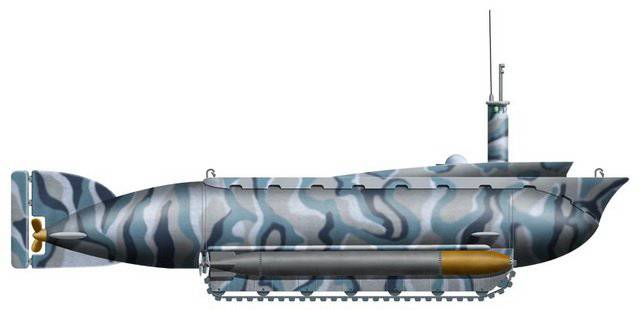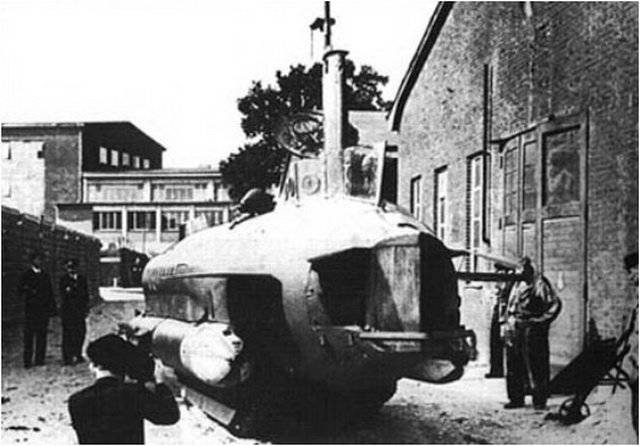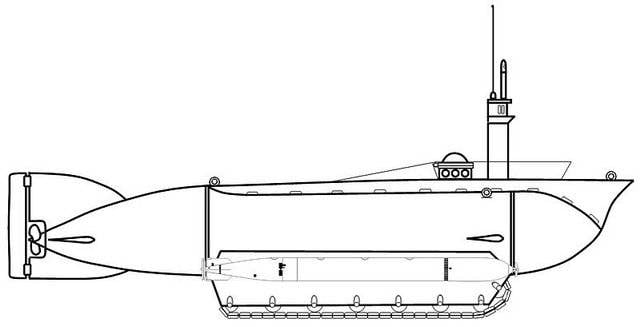"Zeeteyfel" - amphibious submarine with tracked mover
At the very beginning of the war, German experts who were impressed by the design of the Japanese ultra-small submarines (they were first used in December 1941 during the attack on the American base Pearl Harbor) tried to buy the development of Japanese engineers, but the German allies in the war rather zealously guarded their military development. As a result, 2 of the year passed before Reich managed to build the first sample of his own miniature submarine. The main purpose of these cheap, small, small-sized ships was to be a reflection of possible aggression from Britain and the United States on the northern coast of France.
However, they failed to prevent the Allied invasion of France and the opening of a second front in Europe with the creation of their ultra-small submarines in Germany. In general, the results of the German super small submarines can hardly be called outstanding. During the entire war, they were able to sink a number of warships and transports of the Allies with a total displacement of about 12 million tons, while losses according to German data amounted to the 81 boat. According to the British data, they were even higher and amounted to 105 mini-submarines.

Despite the rather modest effectiveness of the application, German engineers were able to create a number of interesting mini-submarine projects. One of them was a kind of crossing a submarine with a tank. This very interesting example was the ultra-small amphibious submarine "Seeteufel" (translated from German as "monkfish") with a caterpillar mover. This boat was intended both for independent carrying out torpedo attacks and for delivering small groups of swimmers-saboteurs to the target of the attack.
Seeteufel was a rather unusual, even amazing, development. This "pocket" submarine was supposed to feel at home on the water surface, under water, and on land. This combat apparatus, as if descended from the pages of books by the famous science fiction writer Jules Verne. This boat attracted special attention and sympathy from the sabotage detachment "K" specially created in the German fleet. Members of this squad are accustomed to evaluate military equipment from the point of view of its combat use behind the front line of the enemy, so they could not but like this machine.
The idea of the Zeetefel design was not a German engineering revelation. German engineers borrowed the idea from an experimental Italian torpedo "boat-tank", which was designed during the First World War. The machine was called the “Grillo” and was intended to break into the main naval base of Autstra-Hungary, Paul. “Cater-tank” was equipped with two tracks that were intended to overcome the booms located in front of the entrance to the naval base.

The unique “Grillo” vehicle was used in a combat situation on the night from 13 to 14 in May of 1918, when it launched an attack on the flagship of the Austrian fleet, the battleship Viribus Unitis. At the same time, the “boat-tank” managed to successfully overcome the 3 lines of anti-torpedo networks and booms. "Grillo" was able to release both of their torpedoes, which hit the target, but in the confusion the Italians forgot to put them on the fighting platoon. So the campaign ended in nothing, although the Italians were able to prove that the concept of the “boat-tank” proposed by them has the right to life and is completely realizable.
German design engineers, who also worked on the possibility of penetrating the fortified bases of the enemy, primarily the British, turned to the principle that was used in the Italian “Grillo. In this case, the Germans instead of the boat took the basis of a miniature submarine, equipped with a conventional diesel-electric propulsion system. The drive on the tracks was carried out using a diesel engine. According to the calculations made by engineers, this amphibious submarine had to get out of the water without any problems and then calmly descend into the water.
To launch the monkfish into the water, there was no need for either special stocks, nor special carts, or the attraction of auxiliary personnel. The hull of this baby boat was placed on a tracked chassis. The device went down into the water independently anywhere in the coast and, if necessary, could go ashore, for example, when the attack object was located on land in the enemy rear or the crew simply wanted to rest on the coast. The crew of the "Seeteufel" consisted of 2-s people. With its course, the Zeetoyfel could move through water at a speed of 10 nodes, and on the ground at speeds up to 9 km / h. It was assumed that in a fully submerged state of oxygen supply the crew should have been enough for 100 hours. The maximum immersion depth was 21 meter. The sailing range of the boat was to be 1000 miles.

Monkfish was a 14-meter cigar-shaped submarine, which was located on 2's relatively short tracks. The width of the boat was 2 meters, displacement was equal to 30 tons. The tracked chassis was powered by an 80-strong car engine, and the propeller of the boat was rotated using an electric motor. The naval armament of the apparatus was to include 2 torpedoes, which were enough to put an enemy ship to the bottom or 2 mines. For land combat submarine amphibious could be equipped with a machine gun or flamethrower.
The main purpose of this unusual apparatus were sabotage at sea. As conceived by the German designers, such a boat during the day could pretend to be a conventional fuel tank and wait at the pier for the onset of the dark time of the day. At nightfall, the Zeetoyfel took on board two members of the crew and, under its own power, crawled into the sea, sank under the water and secretly selected the enemy’s ships or other objects to conduct an attack.
An experimental model of an amphibious submarine was built in metal, and in July, 1944 of the year began tests that were not very successful. It quickly became clear that the diesel engine used was too weak, and the tracks used were too narrow, which caused the submarine to get stuck on soft soils and could not move forward. Amphibious submarine just stuck on the sandbanks. Therefore, it was decided that the boat, equipped with a much more powerful diesel engine in 250 hp, as well as an electric motor in 100 hp, will go into the series. After the shortcomings identified during the tests were eliminated, the chances appeared that this amphibious boat would still be commercialized in the 1945 year. But these plans did not come true. Germany by that moment was already losing the war on all fronts, the Reich was not in the mood for the construction of very exotic mini-submarines. The only boat built at the end of the war was transported to Lübeck, where it was scuttled as the Allied forces approached the city.
Information sources
- http://www.fourthreich.info/forum/viewtopic.php?f=178&t=1972
- http://militera.lib.ru/h/bekker/11.html
- http://wunderwaffe.narod.ru/Magazine/BKM/Germ_VMF/23.htm
- http://en.wikipedia.org/
Information